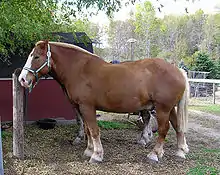Belgian horse
The Belgian or Belgian Draft, French: Trait belge, Dutch: Belgisch Trekpaard, is a Belgian breed of draft horse. It originates from the Brabant region of modern Belgium, and is one of the strongest of the heavy breeds. The breed associations are the Société Royale Le Cheval de Trait Belge/ Koninklijke Maatschappij van het Belgisch Trekpaard and the Eleveurs Wallons du Cheval de Trait Belge/ Vlaamse Fokkers van het Belgisch Trekpaard.
 | |
| Other names |
|
|---|---|
| Country of origin | Belgium |
| Distribution | world-wide |
| Traits | |
| Weight | |
| Height | |
History

Historically, it is theoretically possible the Belgian may have had ancestors that were destriers in the Middle Ages, although no independent evidence supports this claim. The foundation stock for the Belgian was originally known as the Brabant. Other names for essentially the same breed include the Cheval de trait Belge, Brabançon, and Belgisch Trekpaard.[3] Until the 1940s, the Belgian and the Brabant were essentially the same breed. Following World War II, the Brabant in Europe was selectively bred to be thicker bodied and heavier - while in the United States, the Belgian was bred to be somewhat taller and lighter bodied.[3] The main use was as a farm horse. Closely related breeds include the Trait du Nord and Nederlands Trekpaard.[3]
In 1887, the American Association of Importers and Breeders of Belgian Draft Horses was founded in Wabash, Indiana, to register and keep track of all Belgian Draft Horses.[4] Today, the Belgian is the most numerous breed of draft horse in the United States.[5]
Importation of Belgians to the United States slowed during the Second World War with Erwin F. Dygert transporting the last Belgians out of Europe as the war was beginning.[6]
Characteristics
The Belgian Draft stands between 16.2 and 17 hands (66 and 68 inches, 168 and 173 cm).[7] On average the Belgian grows to weigh slightly over 900 kilograms (2,000 pounds). Most American Belgians are a light chestnut with a flaxen mane and tail. The head is relatively small and well-shaped.[7] American Belgians in North America are not as large as the European Brabant but are of a similar build.[7]
Belgian Draft's have straight or slightly concave profiles; short and muscular necks; powerful loins; short, broad backs; heavily muscled gaskins; medium-sized hooves with lean and strong legs with some amount of feathering. [8]
Currently, the world's tallest horse is a Belgian Draft horse named Big Jake, a gelding born in 2000. He stands 20.2 3⁄4 hands (82.75 inches, 210 cm) tall.[9][10]
The world's largest Belgian Draft was named Brooklyn Supreme. He weighed 3,200 lb (1,451 kg) and stood at 19.2 hands (78 inches, 198 cm).[11][12]
Belgians have a high occurrence of junctional epidermolysis bullosa (JEB), an inherited genetic disorder that causes newborn foals to lose large areas of skin and have other abnormalities, normally resulting in euthanasia. A study conducted in 2001–2003 found that 17.1% of tested Belgians in the US and Canada were carriers, including 13.5% of stallions and 28.9% of mares. If carriers are not mated, JEB can be avoided, and scientists are studying the disease further in the hope of completely eliminating it.[13] The US Belgian breed registry requires JEB testing.[14] Belgians have also been identified to be at risk for chronic progressive lymphedema, a chronic progressive disease that includes symptoms of progressive swelling, hyperkeratosis and fibrosis of distal limbs. The disease is similar to chronic lymphedema in humans.[15]
Uses
.jpg.webp)
Belgians are still used as working animals, but have also become popular as show horses, and pleasure riding horses. The Brabant and related breeds remaining in Belgium today are also desirable for horse meat, producing a tender meat that is considered a delicacy.[16]
Belgian horses are able to pull tremendous weights. At the National Western Stock Show in Denver, Colorado, a team of two horses in the Heavyweight class pulled 17,000 pounds a distance of 7 ft 2 in (7,700 kg a distance of 2.18 m). The team of Belgians weighed 4,800 pounds (2,200 kg). At the Iowa State fair, the heavyweight champions in the pulling contest pulled 14,600 pounds the complete distance of 15 ft (6,690 kg, 4.6 m). The team consisted of one Belgian and one Percheron and weighed 3,600 pounds (1,600 kg).
Other meanings
In Britain, "Belgian Black" is a colloquialism used to describe a Friesian horse.
References
- Summerhayes, RS; "Horses & Ponies", Warne & Co, 1948
- Breed data sheet: Cheval de Trait Belge/Belgium. Domestic Animal Diversity Information System of the Food and Agriculture Organization of the United Nations. Accessed October 2014.
- "American Brabant Association". Archived from the original on 2014-11-07. Retrieved 2014-11-15.
- Self, Margaret C. The Horseman's Encyclopedia. New York: Barnes & Company Inc, 1963.
- "America's Favorite Draft Horse-The Belgian". The Belgian Draft Horse Corporation of America.
- Belgian Draft Horse at International Horse Museum Archived January 12, 2009, at the Wayback Machine
- "Breed Profile". Equisearch. Retrieved 2013-08-19.
- https://www.horsebreedspictures.com/belgian-draft-horse.asp
- "Archived copy". Archived from the original on 2014-11-29. Retrieved 2014-09-02.CS1 maint: archived copy as title (link)
- http://www.guinnessworldrecords.com/world-records/209677-tallest-horse-living
- "Picture of Brooklyn Supreme". Rural Heritage.
- "The World's Biggest, Tallest, Largest Horses". Archived from the original on 2010-09-25. Retrieved 23 October 2010.
- Church, Stephanie L. (March 1, 2004). "JEB in Belgian Draft Horses". The Horse. Retrieved 2009-10-23.
- "Bylaws of the Belgian Draft Horse Corp" (PDF). Archived from the original (PDF) on 2011-07-07.
- "Chronic Progressive Lymphedema (CPL) in Draft Horses". University of California, Davis. Archived from the original on 2013-02-03. Retrieved 2010-05-22.
- Brady, Irene. America's Horses and Ponies. Boston: Houghton Mifflin Company, 1969.
External links
 Media related to Belgian draft horse at Wikimedia Commons
Media related to Belgian draft horse at Wikimedia Commons
